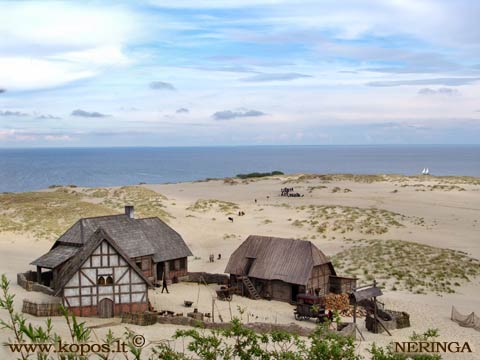| The Curonian Spit, is a narrow strip of sand stretching 97 kilometres along the Baltic Sea in western Lithuania. According to the legend, the spit was formed a long time ago by Neringa, a girl giant who poured the sandy peninsula into the Baltic Sea to protect the peaceful bay from the stormy sea and create an embankment for fishermen to live. Thus, today the eastern shores of the Curonian Spit are washed by the Curonian Lagoon, while the Baltic Sea washes the western ones.
One part of the 50 kilometres long Curonian Spit belongs to the Republic of Lithuania. The other to the Russian Federation. With its still drifting sand dunes, the sea side forests cherishing the hundred-years-old pine trees, dunes covered by a mountain pines’ carpet planted by hand, white sand beaches and the old fishermen villages, the Curonian spit is truly unique! In order to preserve the valuable landscape complex, Curonian Spit National Park was established in 1991.

Cultural and natural heritage of international significance
In 2000, the Curonian Spit cultural landscape was inscribed on the UNESCO World Heritage List. Human habitation on this elongated sand dune peninsula dates back to prehistoric times. Throughout this period it has been threatened by the natural forces of wind and waves. Its survival to the present days has been made possible only as a result of ceaseless human efforts to combat the erosion of the Spit, dramatically illustrated by continuing stabilization and reforestation projects.
The area of the park is 26 464 hectares: 9 764 ha are covered by land, and 16700 ha by water.
The Curonian Spit is part of “Natura 2000”, a network of protected territories in Europe, connecting its most valuable natural habitats. It is also belongs to HELCOM, which seeks to protect the marine environment of the Baltic Sea through intergovernmental cooperation.
Natural values
The dunes are an exclusive element of the Curonian Spit landscape. Here you can explore all stages of dune formation. You will find embryonic shifting dunes, humid dune slacks, decalcified fixed dunes, wooded dunes, white and grey dunes, which are famous for their exceptional beauty.
Eleven types of protected habitats of European importance occur in the Curonian Spit. The different habitats are home to rare species of insects, birds, and plants specific and typical for the place. Some of them are endangered and included in the Red Book of Lithuania. There are 37 species of mammals living in Curonian Spit. Here, you meet fox and hare, boar and beaver, roe deer, elk, and many other mammal species.
Every year millions of birds fly through the area as the migration route from the Baltic Sea to the White Sea runs through the Curonian Spit. The coastlines along the Curonian Spit Lagoon and Baltic Sea are important for migratory and wintering water birds. In addition, there are large concentrations of migrating passerines and birds of prey, and the Curonian Spit is famous for the largest breeding colony of Great Cormorants in Lithuania. This is a true paradise for bird watchers!
Culture and traditions
The rich cultural heritage of the Curonian Spit includes fishing settlements that are considered valuable both from an ethno-cultural, historical and aesthetic point of view. There are architectural works of unique scale and archeological sites, mostly villages buried under the sand.
The settlements of the Curonian spit until the 19th century were typical fishing villages – monuments of special significance to the kursiai community way of living and ethnographic traditions which are not maintained anymore. The earliest fishing settlements were buried in the sand when the forest cover was removed. Those that have survived since the beginning of the 19th century are all to be found along the coast of the Curonian Lagoon. There is a specific structure of fishermen homesteads with traditional wooden dwellings, coloured dark brown and blue and decorated with wooden carvings on the gables.
Of special significance are the traditional grave markers known as krikstai. These are timber planks decorated with flowers, hearts and even animal motifs such as birds’ silhouettes.
Come visit us!
Curonian Spit National Park is an outstanding place that allows visitors to explore and get to know nature, culture and traditions in a way that is active and environmentally friendly. The Curonian Spit is a perfect place for observing wildlife, sustainable tourism, leisure and cultural self expression. Here you can enjoy cycling, hiking and canoe tours, sailing trips and try traditional fishermen’s food. There are numerous destinations that attract many visitors each year: The Sea Museum and Dolphinarium, Historical Museum of Neringa, Galleries of Amber and Weathervanes, Thom Mann Memorial Museum and the Ethnographic Farmstead of Fisherman. The Hill of Witches and cognitive path “Nature Puzzle” are favourites among children. People of all nations and ages are warmly welcome!

|
| Recently Spotted MembersNo members found. Be the first. |








